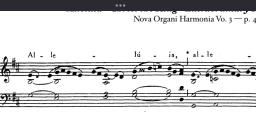Neumes plus Modern Notation in Musescore
-
Chant notation in Dorico has been much discussed recently. I thought I'd share this score of the introit Ne derelinquas me which I managed to produce in Musescore. It was... difficult. The accompaniment is not my own.

 Ne_derelinquas_me.pdf74K
Ne_derelinquas_me.pdf74K -
Dan’s font?
-
No, just whatever font Musescore uses for "insert special characters"Thanked by 1ServiamScores
-
In version two I have enlarged the chant further

 Ne derelinquas me v0.2.pdf67K
Ne derelinquas me v0.2.pdf67K -
Yeah. It’s awful. I wouldn’t even want Musescore’s devs to support it, it’s that bad — and they have other problems.
-
The neumes are too disconnected… I don’t see what the reason is to do this.
-
I think it is to help the accompanist. (It would help me.) It’s not for the singers. They need a normal score.Thanked by 1GerardH
-
Precisely. On the occasions when I decide to use a composed accompaniment instead of improvising one, I find trying to follow the chant from the modern notes alone fairly difficult and unintuitive.
This setup would also allow me to make chant scores on a modern staff, á la the Weinmann Graduale. I'll try and post one in the next few days.Thanked by 1ServiamScores -
This is precisely the type of thing I’m interested in developing too. I did my psalm setting two weeks ago in the same style (although admittedly, it’s simpler and just a psalm tone, but it’s the same idea). https://psallitedomino.com/blog/free-score-psalm-128-may-the-lord-bless-us-psalm-tone-viii-g-2024
-
> I don’t see what the reason is to do this.
This is approximately the same notation style as the 1906 uses for chant hymns.
(The difference being those are not melismatic. But still... square note vocal line with modern notes accompaniment has several precedents... and yet it continues to be unsupported by the major notation softwares)
@GerardH
Have you tried Lilypond? (I don't *know* that it can do this, but I *think* it could)Thanked by 1ServiamScores -
Once you break the chant apart with large spaces it is easier for me to just read all modern notation… hey, but that is me.

 IMG_0283.jpeg1459 x 559 - 213K
IMG_0283.jpeg1459 x 559 - 213K -
Well Lilypond’s chant support is also bad. The example in the documentation is egregious.Thanked by 1Adam Wood
-
In creating a "hybrid notation" - incorporating GC notation with modern notation - it seems one should keep the chant notation in tact... (the philosophy of chant notation is that the words are king and DICTATE the rhythm [and spatial (horizontal)] display of neumes). When the neumes become disassociated from one another, the rhythm is fragmented.
-
Sure, but how do you indicate a harmonic change on the second note of a podatus (e.g. the salicus as notated in the old Solesmes, or the note above a quilisma)? When there isn't enough space for the accompaniment, something has to give. Don't let the perfect be the enemy of the good.Thanked by 1ServiamScores
-
It is (mostly) true that for Solesmes-style accompaniment that you would only change on an ictic note but I would either just annotate it or use modern notation to avoid ambiguity. Making the salicus look like not-a-salicus would be hard to use in other ways.
A quilisma would be less challenging imho. -
Welcome to the MusicaSacra Forum!
To participate in the discussions on Catholic church music, sign in or register as a forum member, The forum is a project of the Church Music Association of America.
Categories
- All Discussions21,074
- General Music Discussion8,206
- Job Openings193
- Management of Music Programs850
- Choral Matters532
- Church Documents and Rubrics524
- CMAA Notes300
- Events713
- For Newcomers: Read First26
- Sacred Polyphony546
- Hymnody871
- Gregorian Chant: General2,694
- ↳ Graduale Romanum and Liber Usualis367
- ↳ Graduale Simplex60
- ↳ Semiology63
- Vernacular Plainsong696
- Anglican Use and Anglican Chant68
- Organ, Other Instruments and Repertoire434
- New Composition/Works in Progress1,288
- Recordings230
- Music for Hispanic Ministry159
- Music Education: Children211
- Music Education: General222
- News Items245
- Positions Wanted2
- General Discussion: Catholicism738
- Amusements176
- General Discussion1,033
- Opinions117

